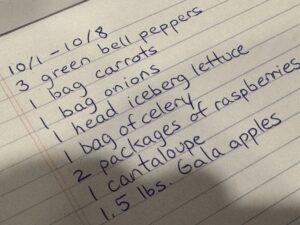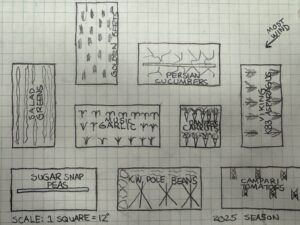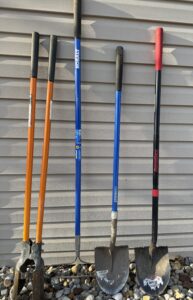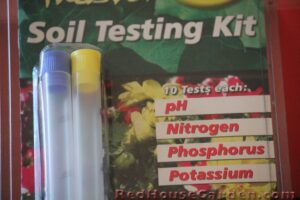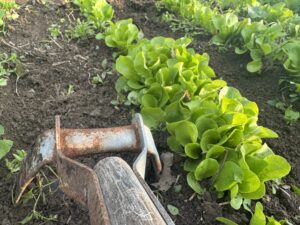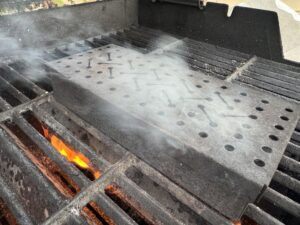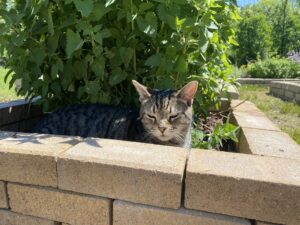1. Identify What You Already Eat
I’m starting with this one because it should always be our first consideration as gardeners before we move the first shovelful of dirt, yet many don’t give sufficient intentional thought to what crops and how much of each they grow. Before they know it, they are composting perfectly fine produce because they don’t know how to use what they spent so much time growing and are pleading with their neighbors to accept shopping bags full of surplus zucchini.
A lot of people who want to start a garden but don’t have one yet often ask me, “What grows well in our area?” Well, the answer to this question, as with most is, “it depends”. Do you want to know what crops do well in your area, or do you want to know what crops that you use or plan to start using do well? Go buy a small pocket notebook and write down every fruit, vegetable, and herb that you buy from the grocery store for the next month. You don’t want to waste your time growing things that you aren’t going to use or open to trying, regardless of how easy it is or how much it costs at the store. Sure, you can grow a beautiful radish in 29 days with very little work, but if you or no one in your family east radishes, what’s the point? Per pound, radicchio can approach the price of a medium-quality steak, but there’s no point in growing it if you detest its objectively (but delicious, in my opinion) bitter taste.
Once you have your list, cross off anything that you know for sure you can’t grow in your USDA Plant Hardiness Zone. You can find which zone you’re in by entering your ZIP code here. Next, identify what you use but would prefer to buy from the store or farmers market, whether it’s because it’s inexpensive to buy, its season is too short to reliably grow where you live, or because the work required to get a satisfactory and worthwhile harvest is more than you’re willing to put in (which is a perfectly sound calculation you should make with every crop you plan to grow).
Your time and effort that you’re realistically going to put in with your garden is finite. Consider how much of both you are willing to dedicate before you finalize your plan for what, when, where, and how much of a crop to plant and evaluate this calculation with your desire to grow this particular crop yourself. Take potatoes for example. I don’t grow them because of how cheap they are to buy at the grocery store and because there isn’t as much of a drop-off in quality with a lot of root crops as there is with crops such as tomatoes and berries. I enjoy eating potatoes and they might make my cut every once in awhile if I feel like making some space for them, but they’re going to be low on my priority list. Likewise, I strictly limit the space I dedicate to strawberries (even though homegrown ones are superior in every way) because they have such a short production period and I can’t do anything else with the bed the rest of the year. I buy my sweet cherries because I don’t want to mess with climbing ladders and putting nets over trees to keep the birds from taking everything and fighting root rot that is common with these trees in our heavy native clay soils.
Consider the remaining items on your list. Which ones are easy to grow but quite expensive to buy (herbs and salad greens, for example)? Are you willing to or interested in learning how to use it? Which ones are easy to can, freeze, or dehydrate, thereby allowing you to enjoy your harvest year-round? Of the things on your list, what would you enjoy taking care of the most in your garden? Which fruits, vegetables, and herbs would make you the happiest when you go out to your garden? Are there any that you might want to grow because of your personal culture or ethnicity as a matter of pride or to carry on a family tradition?
Beyond narrowing down the list of what you’re going to grow based on foods you will actually consume, it is prudent to consider what storage and/or preservation methods you have at available and are proficient with. Having an upright or chest freezer in the garage or basement would tilt the scales toward growing a bulk crop of green beans for me, since I much prefer properly blanched and flash-frozen green beans to canned beans.
Are the crops you’re considering growing ones whose fruits will hold reasonably well on the plant for a couple of weeks, or will you have to harvest and use them within a tight window to enjoy them at their freshest? Bear in mind what your personal or family schedule will look like when it comes time to harvest. I can tell you from experience that my motivation level was a lot higher starting multiple varieties of cucumber seeds in my garage on a mild June day than it was rushing to pick them before they get too big on an oppressively hot and humid August afternoon in between taking the kids back and forth to football and gymnastics.
2. Plan Your Garden on Paper
Staring at an empty area of lawn where you intend to make a garden can be intimidating to a first-time gardener. It’s natural to want to get things right the first time considering how much work and money are involved to get started. Sometimes our imagination is larger than the space we have, and we have to eliminate things we wanted. Other times we suffer from analysis paralysis and struggle to visualize how everything will be laid out in a way that works. The following tip will save you time and money as well as help ensure that your finished garden – well, gardens are never really finished – looks close to how you pictured it in your mind.
Putting your garden on paper gives you a more detached perspective than you will have if you are standing in it. Make a sketch to scale of your existing beds, paths, and any structures that could affect the hours of shade or potentially be used to support plants. Your sketch doesn’t have to be elaborate; the idea is that you have realistic expectations for what and how much you can grow in the space that you have. Indicate the cardinal directions and note where the wind tends to come from where you live. Use different weights of pencil to shade in the areas of your garden that don’t get morning or late afternoon sun.
Planning your garden in this way helps you buy the appropriate quantity of seed for whatever seasons you’re growing in. It’s easy to cross-check your labeled diagram with the seeds you have on hand to determine whether you have everything you need so you’re not paying for unnecessary postage or making extra trips to the store.
I suggest making photocopies of your sketch once you’re satisfied with it, as you’ll be able to play around with different options and lay out your plans for succession crops. Keep these sketches with the rest of your records, as you’ll enjoy seeing how your garden has evolved over the seasons. That’s what’s great about planning a garden and being able to reinvent it from year to year – it all comes down to what you want from your unique space and how much time you are willing to invest at certain times of the year.
Fans of square foot gardening (more on this in articles to come) would be wise to buy some graph paper and play around with the grids as they plan what they’re going to grow.
3. Clean and Inventory Your Tools
Many prospective gardeners overestimate how many tools they will need to build and maintain a garden. Take an inventory of what you already own and evaluate the condition of each tool before you move the first ounce of dirt. A basic digging shovel, a garden rake, a chopping hoe, and a hand trowel is all you need to get started for a basic hobby garden. You can buy a decent quality one of each for under $100. Lowe’s and Home Depot both offer lifetime warranties on some of their house-name hand tools, so keep track of your receipts and you’ll never have to buy new ones. There are plenty of other tools and pieces of equipment that can make life easier down the road as your garden grows and you develop new skills, but stick with the basics until you get to the point where the need for a specialty tool becomes self-evident.
Whether this is your first or your fifteenth year with a garden, it’s important that you have the necessary tools and that they are maintained and ready to go to work before you start your first seed so you don’t start the season overwhelmed and unprepared. Springs in central Ohio are unpredictable; we really can go through all four seasons in just two or three days. I want to be able to work quickly and efficiently when we get an unseasonably warm and dry spring day out of nowhere.
I make sure all my digging implements, pruners, and outdoor power equipment are ready to go. It’s always a best practice to clean and oil shovels, rakes, and hoes before putting them away at the end of every season, but it’s still a good idea to put a set of eyes on everything in case you missed something. I work in a coat of linseed oil into the wood handles and the steel of all my tools. This is also a good time to sharpen shovels, spades, hoes, as well as pruners.
Buy fresh fuel for your small engine equipment a couple of weeks before you anticipate using it. It’s a best practice to use untreated gasoline within 30 days with how much ethanol they put in modern fuel. I like to add a bit of Seafoam motor treatment to my gas cans to keep it stabilized and prevent condensation. Start the season with fresh oil that is the correct weight and specification for your engine (you should have changed it before you put it away the prior year, as acids accumulate in worn motor oil and cause corrosion and pitting.) Check and clean your air filter, lubricate throttle and choke cables, and take a look at your spark plug to inspect for excessive wear or improper combustion that could indicate a problem with the carburetor or air/fuel ratio.
4. Test Your Soil
Don’t be intimidated by the thought of testing your soil even though you’re still a little unsure about the chemistry and vocabulary behind plant biology that you’ve been hearing about as you explore this hobby. It sounds like something only a more experienced gardener should be concerned with, but it’s actually more important for a first-time gardener to test their soil because you have no idea what is or isn’t in your soil and there’s a good chance that a new garden bed is deficient in at least one area. It’s necessary to test your soil to determine its pH and the level of existing nutrients, to identify nutrient deficiencies and needs, and to plan for any potential growing constraints. The good news is that it’s much easier than it sounds. You’ll save at least the amount of money you spend to test by not buying unnecessary amendments and fertilizer and you’ll avoid the frustration of trying to grow crops that won’t do well with your current soil.
You can order a soil test kit that you mail in for a nominal cost (ours is $15) from your county’s agricultural extension office. Virtually every county in the United States has one or is a member of a consortium with neighboring areas. These offices are the most underutilized resources available to hobby and pro gardeners alike. They are staffed by who are familiar with your local climate and soil type, as well as the pests and diseases that are likely to afflict your garden. These agents are more than happy to provide free consultations to make sure you’re successful. Your taxes already pay for these services, so take advantage of them as you meet local experts and make some new friends in the process.
If you would rather do it yourself or if you have a bunch of beds that might have very different soil biomes due to how long they have been established or the type of soil amendments you have added, there is a wide variety of kits ranging from cheap and questionably accurate to pricey but professional quality.
5. Get Yourself in Shape
The last item on this list is something most gardeners don’t think about as much as they should to ensure they are physically capable of maintaining their plot without putting themselves at unnecessary risk of injury. One of the most appealing things to me about growing vegetables, fruits, and flowers is that it’s a hobby that you can start when you’re very young and enjoy well into your sunset years as long as you take reasonable care of your body.
Having reasonable cardiovascular endurance, good flexibility, and some muscle tone throughout all your major body systems makes it easier to complete gardening tasks and less likely that you will injure yourself. People of all ages and physical abilities can enjoy gardening, but why make it harder on yourself and make the time you spend out there feel like a burden rather than an opportunity to get in some whole-body exercise that you’re conditioned for? You don’t want to come to the realization that you’re not in poor physical shape the first nice day of spring when you’re spending hours digging, lifting, and bending to get your garden ready.
Running or walking on a treadmill (or outside), using a stationary bike or elliptical, and swimming throughout the winter months are all excellent ways to maintain your cardiovascular health. Doing daily stretches before you start your day relaxes your mind, significantly improves your flexibility, and decreases your chances of injury while doing daily activities. You should always consult your doctor before beginning or radically modifying an exercise regimen to ensure that you don’t have any underlying conditions that could be aggravated. I lift heavy weights at the gym several times a week and use my Rogue Echo air bike every single day, but I still feel like I get a workout in when I spend an hour or two doing maintenance in the garden due to how much it engages the core and the smaller stabilizer muscles that we don’t exercise consistently.
Finally, making smart decisions about the foods you eat throughout the year will keep you full of vim and vigor to motivate you to put in the work that is necessary to produce your own healthy produce. Every athlete understands that you can’t outtrain a bad diet. Eating a variety of mostly whole foods and avoiding highly processed foods and added sugars year-round helps ensure physical and mental well-being and is the easiest way to maintain a healthy body weight. Many people eat an excess of so-called comfort foods during the winter months. While I believe all foods are fine in moderation, you don’t want a poor or imbalanced diet to creep up on you as you’re preparing to be significantly more active once the weather breaks.
I want to welcome you personally to the world of gardening. I hope you have a great first year and learn a lot. As always, do the work, help out another gardener in need whenever you can, enjoy the fruits of your labor, and have fun along the way.
As always, do the work, help another gardener in need whenever you can, enjoy the fruits of your labor, and have fun along the way. Thanks for being part of the Richwood Gardens community.
If you enjoyed this article or found it helpful, I’d truly appreciate it if you shared it with a friend. Also, if you’re interested in learning about some of the items I have found most useful in my own gardening and cooking, you can check them out on my Product Reviews page. As an Amazon Associate, I earn from qualifying purchases, which helps me keep growing so I can bring you even more valuable content.

